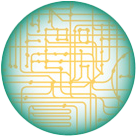Dead or (Still Not) Alive: Patterns and Drivers of Soil Viral Activity, Turnover, and Decay
Authors:
Joanne B. Emerson* ([email protected]), Sara E. Geonczy, Jane D. Fudyma, Christian Santos-Medellín, Anneliek ter Horst
Institutions:
University of California–Davis
Goals
The overarching goal of this project is to assess and compare the contributions of active, infectious viruses and inert viral particles to biogeochemistry across diverse terrestrial ecosystems. Using a multi-omics approach, researchers seek to establish spatiotemporal patterns in soil viral community composition and activity linked to host carbon and nitrogen metabolism in grasslands, shrublands, woodlands, and wetlands. Through laboratory experiments, researchers are investigating the chemical composition, fate, transport, and integrity of viral particles in soil. By integrating field and laboratory experiments across a variety of soil edaphic properties and spatiotemporal scales, this project is expanding the understanding of the soil virosphere and its influence on carbon and nutrient cycling.
Abstract
Viruses are highly abundant but poorly characterized members of the soil microbiome. By infecting soil microbes, viruses likely have substantial impacts on terrestrial biogeochemical processes under their hosts’ control. Viral particles (virions) may also play more direct roles in soil biogeochemical cycling as packets of carbon, nitrogen, and phosphorus, but the time scales and environmental conditions that determine virion infectivity, transport, and/or sorption to soil particles are unknown. This project uses field, laboratory, and computational approaches to distinguish between infective and inert virions and to assess their contributions to soil biogeochemical cycling.
Using a < 0.22 µm viral size-fraction metagenomics (viromics) approach, researchers are exploring the conditions and temporal scales over which virions are produced, remain infective, and decay in soil. Researchers are also tweaking and rigorously testing the viromics protocol to facilitate access to different parts of the soil virosphere, including decayed viral particles and virions with different chemical compositions. Researchers find that soil viromes usually capture very recently active viral communities, but they can be dominated by decayed viral particles after extreme temperature perturbations and in seasonally dry soils. For example, heating experiments revealed that virion survival thresholds are similar to those of bacteria, with a reduction in survival at 60 ºC and nearly complete removal of intact virions at 90 ºC.
Since the viromics method relies on extraction buffers to desorb virions from the soil matrix prior to DNA extraction, extraction efficiency and the composition of the recovered viral community could be affected by interactions among virions, soil, and the chosen extraction buffer. A test of seven buffer chemistries revealed that recovered viral communities were largely unchanged by buffer chemistry. Rather, viral communities differed most significantly by soil type (forest, grassland, or wetland) and differed more significantly just ~1 m apart in the field than by extraction buffer chemistry. Thus, extraction buffer chemistry is likely of much lower importance than ecological considerations, such as spatial distance, in the design of future soil viral ecological studies.
Centered on a highly spatiotemporally resolved viromic study of two habitats in the Jepson Prairie grassland (8 locations, 29 time points from Nov. 2020 to Feb. 2022), the ongoing analyses of >300 viromes seek to unravel the relative contributions of space, time, habitat, and dispersal on soil viral community composition. Briefly, viromes were most distinct by habitat (between mounds and their adjacent swales, defined by differences in topography, plant communities, and hydrology), but each habitat exhibited different patterns over time. Although cumulative viral community richness continued to increase over the multi-year study period, prokaryotic community richness showed signs of leveling off, suggesting much greater viral than prokaryotic diversity.
In sum, the factors that structure soil viral communities differ substantially across scales and habitat characteristics, and a better understanding of these processes will enable more robust predictions of viral contributions to terrestrial biogeochemical cycling.
References
Fudyma, J. D., et al. 2023. “Exploring Viral Particle, Soil, and Extraction Buffer Physicochemical Characteristics and Their Impacts on Extractable Viral Communities,” bioRxiv. DOI:10.1101/2023.11.13.566929.
ter Horst, A. M., et al. 2023. “Dispersal, Habitat Filtering, and Eco-Evolutionary Dynamics as Drivers of Local and Global Wetland Viral Biogeography,” The ISME Journal 17, 2079–89.
Funding Information
This research was supported by the DOE Office of Science, BER Program, grant no. DE-SC0021198.
